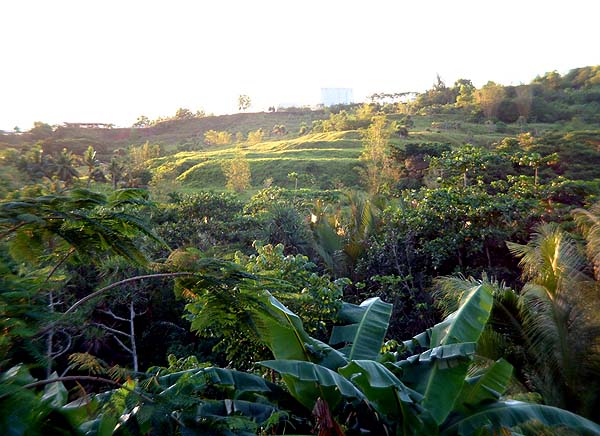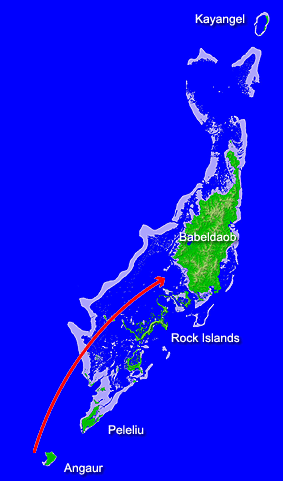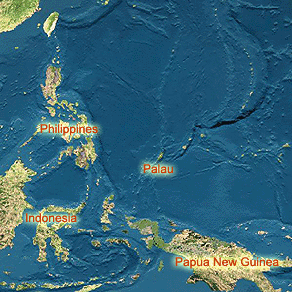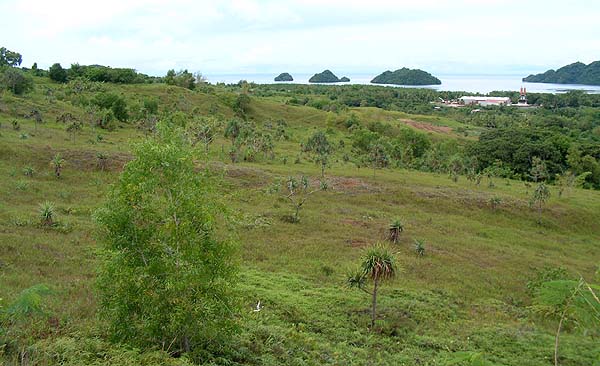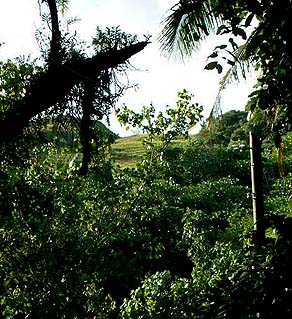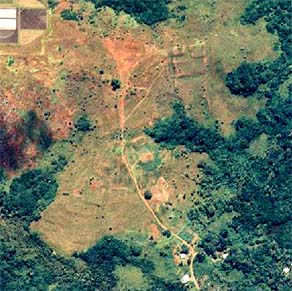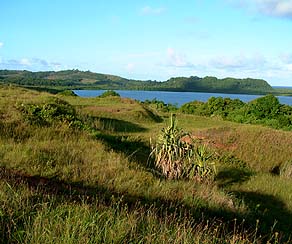 |
 |
 |
 |
||||
|
|
|
|
|
|
|
|
|
|
|
|||||||
|
|
|
|
Ancient terraces near the airport in Airai State.
|
“There are two settlement patterns here in Palau,” Kathy explains. “One from the northern part, Kayangel and up, and one from the southern part—Angaur, Peleliu and so forth. And both are from Southeast Asia, maybe the Philippines, Malaysia, Indonesia. And these expeditions, they weren’t people who organized themselves, like pilgrims on the Mayflower, to get on the canoe and go and establish a new colony. It was by chance, kind of happenstance, and maybe it was some families traveling to another place in the Philippine islands and went adrift and landed here.” “But once they got here, they had their own ways: they had their own language and skills, pottery, agricultural skills and so forth. Once they found the islands, they were able to sustain themselves, and they started gardening and settling in."
|
||
| |
||
“A lot of migrations came over to Palau, according to what studies been done,” Walter says. “The earlier migration to Palau, if there was one, they first settled on the Rock Islands. And there they lived in the caves, and Rock Island villages. "Then maybe when they over-fished, or they didn’t have enough water, since there are few resources over there, so they probably migrated to all the way to the big island, and that is where they are. So most of the old migrations were coming from Rock Islands.” “There was a village up north by Kayangel atoll, up there, called the Ngeruangel, the sunken village. So maybe there was a migration from that direction, from the north too, maybe connected to the rest of Asia. "But all the migrations to Babeldaob are from the Rock Islands. Probably the direction the island people came—the ones occupying this island now—was first to Angaur, Peleliu, then the Rock Islands."
|
|
|
|
“The archaeological books talk of the first wave of Palauans.” Tina points to the many ancient terraces that remain on the Palau landscape. “But when you see the traditional bai beams you don’t see the story of these terraces. Anthropologists and archaeologists, they differ on many things, but they believe the terraces were fortifications. "When the first wave of Palauans came here, maybe there was not enough water, and they probably abandoned them or something. Maybe they were very involved in general warfare, that’s one of the justifications for those things, that they were built for war purposes. But that’s one of the things that needs to be studied.”
|
|
|
|
|
“The terraced hills you see may be part of the agriculture system that these early settlers brought in, " Kathy continues, "and they started that, and they said at some point in time, according to the archaeologists, some of the findings, the dates go as far as 4000 years ago. So it goes back a long time."
|
||
|
|
||
“You can see the different levels all the way up.” Walter points out. “Some of them are just pure fill, not the natural sort of landscape. These are pre-historic, they compare them with those in Asia. They were used at one time. Maybe a different culture was using them. Perhaps that’s where they stayed, or farmed. "Archaeologists dated a lot of artifacts from there, sherds and some charcoal, when they were digging. And these date back before this traditional village. They are not just natural, they are man-made. And these go back 1000, 600-plus years old. "We are trying to preserve these. These are all pre-historic sites too.”
|
|
|
“There is no Palauan tradition regarding the origin of these terraces." Kathy states. "They were fortifications, but they are fortifications in part of a settlement and an agriculture system that they brought in which is very similar to what you see in Malaysia and the Philippines and Indonesia, these terraces. Some of the terraces were homes of the gods who lived there." "In Palauan history, there was an era of half-god half-humans, and they were occupying those terraces. At night they come out to play and do all sorts of things, and have parties and all that. And when sun comes up, they go to those terraces and stay, and sleep all day, and then awake again at night."
|
“In Palauan mythology there is land up there, in the sky, that’s for the gods and various supernaturals, but there’s another level that is a place for half-god and half-human. It sits in between the land and the sky. And then there’s us here. “In terms of history, when we talk, we tend to talk in a way that, if you heard the language, you would think the situation that I’m relating to you happened yesterday. That’s because it’s an oral tradition, and that’s how it’s kept alive and moves on through the years. But it happened a long, long time ago."
|
View across the terraces.
|
|
|
|
“Some say we came from the Philippines, or Indonesia,” Tina muses. “You know, I don’t think so. I think they came from us! The majority of the Pacific has Austronesian languages, except in parts of Papua New Guinea and Australia. "I mean, we were the sailors: you know we had the sailing ships and technology. I like to think that they came from that. And then the islanders populated the Asian countries, and we were left with only a few spread around these whole Pacific islands!”
These thoughts take us to the legendary setting of Palau and Airai State.
|
||
|
|
||
|
|
|
|
|
|

|
| Airai Home | Map Library | Site Map | Pacific Worlds Home |
|
|
|
|

|
|
|
|||
| Copyright 2003 Pacific Worlds & Associates • Usage Policy • Webmaster |
|||
